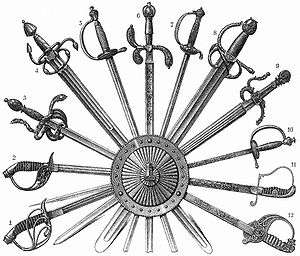Scimitar
| Scimitar | |
|---|---|
 A typical 19th-century Afghan pulwar. | |
| Type | Sword |
| Place of origin | Middle East |
| Specifications | |
| Blade type | single-edged, curved blade |
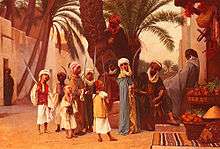
A scimitar (/ˈsɪmɪtər/ or /ˈsɪmɪtɑːr/)[1] is a backsword or sabre with a curved blade, originating in the Middle East.
The curved sword or "scimitar" was widespread throughout the Middle East from at least the Ottoman period, with early examples dating to Abbasid era (9th century) Khurasan.[2] The Persian sword now called "shamshir" appears by the 12th century and was popularized in Persia by the early 16th century.
Names
The name is thought to be derived from the Persian word shamshēr which literally means “paw claw,” due to its long, curved design. The word has been translated through many languages to end at scimitar. In the Early Middle Ages, the Turkic people of Central Asia came into contact with Middle Eastern civilizations through their shared Islamic faith. Turkic Ghilman mamelukes serving under the Umayyad and Abbasid Caliphates introduced "kilij" type sabers to all of the other Middle Eastern cultures. Previously, Arabs and Persians used straight-bladed swords such as the earlier types of the Arab saif, takoba and kaskara.
During Islamization of the Turks, the kilij became more and more popular in the Islamic armies. When the Seljuk Empire invaded Persia and became the first Turkic Muslim political power in Western Asia, kilij became the dominant sword form. The Iranian shamshir was created during the Turkic Seljuk Empire period of Iran.
The term سَيْف saif in Arabic can refer to any Middle Eastern (or North African, South Asian) curved sword. The Arabic word might be derived from the ancient Greek xiphos, but not necessarily as it may have entered Arabic from another source, as both saif and xiphos go back to an old (Bronze Age) wanderwort of the eastern Mediterranean, of unknown ultimate origin. Richard F. Burton derives both words from the Egyptian sfet.[3]
The English term scimitar is attested from the mid-16th century, derives from either the Middle French cimeterre (15th century) or from the Italian scimitarra. The ultimate source of these terms is unknown. Perhaps they are corruptions of the Persian shamshir, but the OED finds this explanation "unsatisfactory".
The following are regional variations of the scimitar:
Morphology
The curved sword, the sabre, is called muhaddab in Arabia and came into use after the Turkish Seljuk migration from Central Asia to Anatolia in the 11th century. The word shamshir is Persian and refers to a straight-edged sword as well as to a curved-edged sword, depending on the era of usage.
The Indian talwar is a sword similar to the shamshir, with the exception of a broader blade, mild curve and a disk shaped pommel which provides a very secure grip. The sword is made from very hard wootz steel. The word "tulwar" literally means "sword" in Urdu/Hindi. The tulwar is unusual in that it can be used for thrusting as well as cutting.
The kilij is a scimitar used by the Turks and the Ottoman Empire; it appeared around the 15th century. The kilij is a unique kind of scimitar that has a slight taper down the straight of the blade until the last third of the sword, when it angles sharply and becomes deeper. After the First Barbary War, a bejeweled kilij was presented to the commanding Marine officer, thus beginning the tradition of granting, to all United States Marine Corps officers, the right to carry the ceremonial weapon as part of that tradition.
The Moroccan nimcha is a scimitar used in the late 18th century, and is usually forged using the blades of older swords, dating from as early as the 17th century, and with blades from countries as distant as Germany. This created a wide variety of nimcha, and almost no two are the same.
The Afghan pulwar is similar in blade design to the tulwar, but the cross guard on the pulwar angles in towards the blade to catch swords. Many pulwar hilts are engraved with ornamental inscriptions and designs.
Use
Scimitars were used in horse warfare because of their relatively light weight when compared to larger swords and their curved design, good for slashing opponents while riding on a horse. The curved design allowed riders to slash enemies and keep riding without getting stuck as stabbing with straight swords on horseback would. Mongols, Rajputs and Sikhs used scimitars in warfare, among many other peoples.
Many Islamic traditions adopted scimitars, as attested by their symbolic occurrence, e.g., on the Coat of arms of Saudi Arabia.
The earliest known use of scimitars is from the 9th century, when it was used among Turkic and Tungusic soldiers in Central Asia.[2][4]
The scimitar is also used in Saudi Arabia as an executioner's tool for beheading.
Gallery
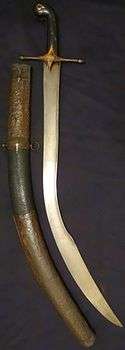 Ottoman scimitar, also known as kilij.
Ottoman scimitar, also known as kilij.- Indian scimitar.
_-_Livrustkammaren_-_13938.tif.jpg) Persian scimitar.
Persian scimitar. Polish scimitar.
Polish scimitar.
Symbolism
.svg.png)

The sword (or saif) is an important symbol in Arab cultures, and is used as a metaphor in many phrases in the Arabic language.
The word occurs also in various symbolic and status titles in Arabic (and adopted in other languages) used in Islamic states, notably:
- In the Yemenite independent imamate
- Saif al-Haqq, meaning "Sword of Truth".
- Saif al-Islam, "Sword of submission to Allah" or (literally) "Sword of Islam", was a subsidiary title borne (after their name and patronym) by male members of the al-Qasimi dynasty (whose primary title, before the name, was Amir), especially sons of the ruling Imam.
- Sayf al-Dawla and variations mean "Sword of the State"
- Saif Ullah Al-masloul the "drawn sword of God" was conferred by Muhammad, uniquely, to the recent convert and military commander Khalid ibn al-Walid.
- Saif ul-Mulk "sword of the realm" was an honorary title awarded by the Mughal Padshahs of Hind (India), e.g. as one of the personal titles (including Nawab bahadur, one rank above his dynasty's) conferred in 1658 by the Mughal emperor Aurangzeb (whose life he is said to have saved by slaying a charging tiger with a single blow) to Nawab Muhammad Bayazid Khan Bahadur, a high mansabdar, whose jagir of Malerkotla was by sanad raised to Imperial riyasat, thus becoming an independent ruler.
- Saif ul-Ali, "Sword of Ali", referring to arguably most famous sword in Islamic history, belonging to both Muhammad, and later, Ali, Zulfikar, and with which Ali slew a Makkan foot soldier, cleaving both his helmet and head, at the Battle of Uhud, and with which he (Ali) slew Amr, a ferocious and devastating Makkan soldier at the Battle of the Trench at Madinah.
Saif and Saif al Din "Sword of the religion" are also common masculine (and male) Islamic names.
The scimitar appears as a symbol of the Russian enemy in the Finnish coat of arms of the Province of Karelia, which depicts two armored arms fighting with swords. The dexter sword symbolizes Swedish forces and the West, while the sinister scimitar symbolizes Russians and the East. Karelia has been a battleground between the Swedish and Russian empires for centuries. From this context, the sword and scimitar have found their way into the coat of arms of Finland, which depicts a lion brandishing a sword and trampling a scimitar. During the period of Russian sovereignty over Finland (1809–1917), the scimitar was moved to the left paw of the lion, only to be returned to being trampled with the independence of Finland in 1917.
 Flag of the Mutawakkilite Kingdom of Yemen
Flag of the Mutawakkilite Kingdom of Yemen Parliamentary Flag of Mexico given by the decree of July 14, 1815
Parliamentary Flag of Mexico given by the decree of July 14, 1815 1836 – Brown Flag of Independence, Republic of Texas
1836 – Brown Flag of Independence, Republic of Texas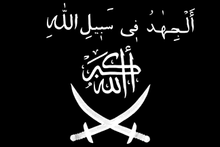 Example of a modern jihadist flag showing two crossed swords.
Example of a modern jihadist flag showing two crossed swords.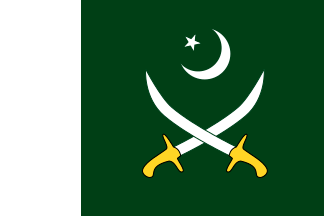 Flag of the Pakistani Army
Flag of the Pakistani Army Badge of Bengali Army
Badge of Bengali Army Flag of a Persian Army Corps General
Flag of a Persian Army Corps General Lion and Sun Emblem of Persia Empire
Lion and Sun Emblem of Persia Empire.svg.png) Peace Flag of Fath Ali Shah (with sword)
Peace Flag of Fath Ali Shah (with sword)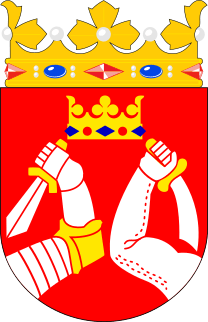 Coat of arms of Province of Karelia
Coat of arms of Province of Karelia
Swords related to scimitar
Stewart%2C_Later_3rd_Marquess_of_Londonderry%2C_1812%2C_oil_on_canvas%2C_National_Portrait_Gallery%2C_London.jpg)
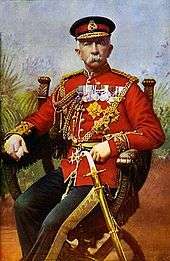
Many swords are related to the scimitar
- Aldaspan (Kazakh language) is a kind of heavy sabre that was used by Turkic tribes in Eurasia.
- Alfanje is a type of Spanish swords. From The Arabic al-janyar "dagger". See Arabic language influence on the Spanish language
- Firangi
- Flyssa (19th-century Algeria)
- Kampilan a single-edged long sword, used by Philippine Moros.
- Karabela was a type of Polish sabre (szabla). It was popular in the Polish-Lithuanian Commonwealth in the 1670s.
- Kaskara (19th-century Sudan)
- Mameluke sword (18th- to 19th-century Egyptian) and modern French, British and American Armies.
- Mohannad an Arabic name of a famous sword type.
- Nimcha (18th-century Morocco)
- Pulwar (Afghanistan) a single handed curved sword from Afghanistan and Pakistan. It is the traditional sword of the Pashtun people.
- Sabre
- Shamshir (Persia)
- Shamshir-e Zomorrodnegar
- Shashka
- Shotel (Ethiopian scimitar)
- Swiss sabre
- Sword of King Carol I of Romania
- Sword of Osman was an important sword of state used during the coronation ceremony of the sultans of the Ottoman Empire.
- Szabla the Polish word for sabre. It specifically refers to an Eastern European one-edged sabre-like mêlée weapon with a curved blade and, in most cases, a two-bladed tip called a feather (pióro). It appeared in the 14th and 15th centuries. Until the 19th century, it served as a symbol of the nobility (szlachta) in the Polish-Lithuanian Commonwealth.
- Takoba (Tuareg sword)
- Talwar (North India) a type of curved sword or sabre from the Indian sub-continent, found in the modern countries of India, Pakistan, Bangladesh, and Afghanistan.
- Zulfiqar is the sword of Caliph Ali.
See also
- Al-Kindi wrote a book on the manufacture of Arabic swords.
- Arabic swords
- Chifle is a dish of Peru and Ecuador, consisting of fried slices of plantain. The term "chifle" most likely comes from the Arabic "chofre", which in Medieval Spain was used to refer to the blade of the sword, lending the name to the snack food of fried plantains sliced into circles with the blade of a sword.
- Cimeter, a common and standard name for a butcher's knife
- Damascus steel, the famous Arabic steel of swords
- Dandoqa, a village in Pakistan, the meaning of which in Arabic is Broken/Cut sharp and lethal sword
- Saiph, the sixth-brightest star in the constellation of Orion, from the Arabic Saif al-Jabbar, سیف الجبّار literally sword of the giant.
- The Golden Blade, a 1953 film.
- Zanahoria is a Spanish word for carrot. The Libyan Tunisian Arabic dialect carrot is known as sfinaria, meaning "The Sword of Fire" (السيف الناري). See Arabic language influence on the Spanish language.
- Metailurini, the clade of felids commonly referred to as "scimitar-toothed cats".
Notes
- ↑ "Scimitar". Merriam-Webster Dictionary.
- 1 2 James E. Lindsay (2005). Daily life in the medieval Islamic world. Greenwood Publishing Group. p. 64. ISBN 0-313-32270-8.
- ↑ Richard Francis Burton (1987). The Book Of The Sword. London, England: Dover. ISBN 0-486-25434-8.
- ↑ "Medieval 2: Total War Heaven: Mongol Weapons". Medieval2.heavengames.com. Retrieved 2012-12-15.
Further reading
- Hawass, Zahi. (2005). Tutankhamun And the Golden Age of the Pharaohs. Washington DC: National Geographic Society
External links
| Look up scimitar in Wiktionary, the free dictionary. |
| Wikimedia Commons has media related to Scimitars. |
